Best Agile Project Management Tools
Best agile project management tools in India include Monday.com, Wrike, Jira, asana, and Smartsheet. Such agile project management software helps manage complicated projects that involve frequent changes to requirements and multiple stakeholders.



No Cost Personal Advisor
List of 20 Best Agile Project Management Tools
Category Champions | 2024
One of the Most Popular Software
This bookkeeping software makes your accounting tasks easy, fast and secure. Start sending invoices, tracking time, and capturing expenses in minutes. We uphold a longstanding tradition of providing extraordinary customer service and building a product that helps save you time because we know you went into business to pursue your passion and serve your customers - not to learn to account. Read FreshBooks Reviews
Explore various FreshBooks features, compare the pricing plans, and unlock the potential of seamless operations by selecting the right software for your business.
Features
View all FreshBooks Features- Dashboard
- Invoice
- Accounts Receivable
- Mobile Support
- Stock Management
- Invoice Processing
- Electronic Signature
- Electronic Receipts
Pricing
FreshBooks Caters to
- StartUps
- SMBs
- Agencies
- Enterprises
Category Champions | 2024
A project management software you'll enjoy using
monday.com Work OS is the no-code project management platform that lets you easily plan, manage, and track projects, collaborate in real-time, and use automations and integrations to streamline workflows and save time. Read monday.com Reviews
Explore various monday.com features, compare the pricing plans, and unlock the potential of seamless operations by selecting the right software for your business.
Features
View all monday.com Features- Dashboard
- Event Management
- Status Tracking
- Access Controls/Permissions
- Editorial Calendar
- Email Tracking
- HR Management
- Sales pipeline management
Pricing
monday.com Caters to
- StartUps
- SMBs
- Agencies
- Enterprises
Contenders | 2024
Tools by Smartsheet Inc.
SmartSheet is the world's leading enterprise SaaS base collaboration solution for organizations and easily to managing and automatically work. It has combines ease use of a spreadsheet with collaborative file sharing. Read Smartsheet Reviews
Explore various Smartsheet features, compare the pricing plans, and unlock the potential of seamless operations by selecting the right software for your business.
Features
View all Smartsheet Features- Contact Database
- HIPAA Compliant
- Field Sales Management
- Project Planning
- Permit Management
- Procurement Management
- Goal Setting / Tracking
- Time Tracking
Pricing
Smartsheet Caters to
- StartUps
- SMBs
- Agencies
- Enterprises
Emergents | 2024
Turn possibilities into plans
FigJam empowers teams to build better products, together. Define ideas, align on decisions, and move work forward—all in one place. Whether you’re breaking the ice or planning a project, FigJam has all of the integrations, widgets, and plugins your team needs. Learn more about FigJam
Explore various FigJam features, compare the pricing plans, and unlock the potential of seamless operations by selecting the right software for your business.
Features
View all FigJam Features- Application Integration
- Agenda Management
- Administrator Level Control
- Animation
- Access control
FigJam Caters to
- StartUps
- SMBs
- Agencies
- Enterprises
Master your team's time
Resource Guru is the fast, flexible way to schedule teams and get work done. Manage people, equipment, and meeting rooms in one place. Track availability in real-time and assign work in seconds. Analyze workloads across clients and projects with insightful reports. Read Resource Guru Reviews
Explore various Resource Guru features, compare the pricing plans, and unlock the potential of seamless operations by selecting the right software for your business.
Features
View all Resource Guru Features- Resource Allocation
- Vacation/Leave Tracking
- Employee Management
- Resource Library
- Capacity Monitoring
- Work Hour Tracking
- Customizable Dashboard
- Employee Scheduling
Pricing
Resource Guru Caters to
- StartUps
- SMBs
- Agencies
- Enterprises
Category Champions | 2024
Tools by Mango Technologies
ClickUp is the complete Task management software. Provide parallel features of Collaboration and Project management. Users can design and assign the task to be sent just for particular things. The notification alerts the employee to the deadline and productive chart. Read ClickUp Reviews
Explore various ClickUp features, compare the pricing plans, and unlock the potential of seamless operations by selecting the right software for your business.
Features
View all ClickUp Features- Collaboration
- Progress Tracking
- Recurring Tasks
- Task Scheduling
- Gantt Charts
- Task Tracking
- Task Planning
- Time Tracking
Pricing
ClickUp Caters to
- StartUps
- SMBs
- Agencies
- Enterprises
Contenders | 2024
Tools by Teamwork
TeamWorks is a cloud-based help desk software. It is suitable for small and medium-size organizations. It includes many functionalities like payroll management, biometric time management for track employee time. Read Teamwork Reviews
Explore various Teamwork features, compare the pricing plans, and unlock the potential of seamless operations by selecting the right software for your business.
Features
View all Teamwork Features- Campaign Management
- Resource Management
- Billing & Invoicing
- Traditional Methodologies
- Create Subtasks
- Task Management
- Business Process Automation
- Calendar Management
Pricing
Teamwork Caters to
- StartUps
- SMBs
- Agencies
- Enterprises
Category Champions | 2024
Leading cloud-based business management solution
Oracle Fusion Cloud ERP is a cloud-based, end-to-end, business management solution designed for mid to enterprise-level customers with advanced capabilities. Read Oracle Fusion Cloud ERP Reviews
Explore various Oracle Fusion Cloud ERP features, compare the pricing plans, and unlock the potential of seamless operations by selecting the right software for your business.
- Employee Database
- Business Process Automation
- Lead Capture
- Check Processing
- Bills of Material
- Quote Management
- Distribution Management
- Bookkeeping
Oracle Fusion Cloud ERP Caters to
- StartUps
- SMBs
- Agencies
- Enterprises
Category Champions | 2024
Powerful collaboration tool for teams of all sizes
Wrike is an online project management software that gives you complete visibility and control across your tasks. Online project management software to establish an advantage and align your team to work quick and active across your organization. Read Wrike Reviews
Explore various Wrike features, compare the pricing plans, and unlock the potential of seamless operations by selecting the right software for your business.
Features
View all Wrike Features- Time Tracking
- Budget Management
- Project Templates
- Project Management
- Job Scheduling
- For Websites
- For Healthcare
- Backlog Management
Pricing
Free
$ 0
User/Month
Team
$ 10
User/Month
Business
$ 25
User/Month
Wrike Caters to
- StartUps
- SMBs
- Agencies
- Enterprises
Contenders | 2024
Tools by Agilean Solutions Private Limited
Agilean Scrum is the best project management system that simply to creates epics, plan sprints and distribute tasks across your work team. The Owner is in charge of conversing with the greater part of the partners and gathering of requirements. Read Agilean Scrum Reviews
Explore various Agilean Scrum features, compare the pricing plans, and unlock the potential of seamless operations by selecting the right software for your business.
Features
View all Agilean Scrum Features- Document Comparison
- Email Tracking
- Requirements Management
- Reporting
- Data Imports/Exports
- Project Templates
- Workflow Management
- Application Integration
Agilean Scrum Caters to
- StartUps
- SMBs
- Agencies
- Enterprises
Emergents | 2024
Tools by VersionOne
VersionOne is a fully featured Project Management Software designed to serve SMEs, Enterprises. VersionOne provides end-to-end solutions designed for Web App. This online Project Management system offers Discussion Boards, Gantt Charts, User Level Management, Defect Tracking, Content Import / Export at one place. Learn more about VersionOne
Explore various VersionOne features, compare the pricing plans, and unlock the potential of seamless operations by selecting the right software for your business.
Features
View all VersionOne Features- Idea Management
- Requirements Review
- Portfolio Management
- Feature Management
- Collaboration
- Test Case Tracking
- Defect Tracking
- Kanban Board
VersionOne Caters to
- StartUps
- SMBs
- Agencies
- Enterprises
Contenders | 2024
Plan, track and collaborate on your projects
Binfire is a complete project management and collaboration tool that supports different project management methods like agile, waterfall and Hybrid. It is easy to use with super fast onboarding. Read Binfire Reviews
Explore various Binfire features, compare the pricing plans, and unlock the potential of seamless operations by selecting the right software for your business.
Features
View all Binfire Features- Group Calendars
- Contact Management
- Document Management
- Reporting
- Portfolio Management
- Status Tracking
- Resource Management
- Gantt Charts
Pricing
Basic Plan
$ 5
User/Month
Binfire Caters to
- StartUps
- SMBs
- Agencies
- Enterprises
Contenders | 2024
Manage projects and communications in one place.
Nifty is a project management platform that helps you simplify your teams’ workflow. Whether you want to manage projects, collaborate for discussions, or communicate with a team member, Nifty facilitates everything. Right from consolidating tasks to setting deadlines and making the workloads of your team clear, it enables you to create an actionable plan for your projects. Read Nifty Reviews
Explore various Nifty features, compare the pricing plans, and unlock the potential of seamless operations by selecting the right software for your business.
Features
View all Nifty Features- Discussion Threads
- Task Management
- Milestone Tracking
- Client Management
- Workflow Management
- Team Management
- Gantt/Timeline View
- Collaboration Tools
Pricing
Starter
$ 0
Per Month
Pro
$ 89
Per Month
Business
$ 124
Per Month
Nifty Caters to
- StartUps
- SMBs
- Agencies
- Enterprises
Category Champions | 2024
Tools by Atlassian
Jira is a issue tracking software, developed by Atlassian. It provides bug tracking, issue tracking, and project management feature for small, medium and large team. Read Jira Reviews
Explore various Jira features, compare the pricing plans, and unlock the potential of seamless operations by selecting the right software for your business.
Features
View all Jira Features- Supports Scrum
- Time Tracking
- Project Scheduling
- Budget Management
- Status Tracking
- Task Management
- Project Tracking
- Process/Workflow Automation
Pricing
Free
$ 0
Per Month
Standard
$ 8
Per Month
Premium
$ 15
Per Month
Jira Caters to
- StartUps
- SMBs
- Agencies
- Enterprises
Emergents | 2024
Project Management Software for Agile Teams
VivifyScrum is a web-based agile project management tool for handling all aspects of a business. It is available as a web, a desktop, and iOS app. Scrum and Kanban collaboration boards, Team and Time management, Invoicing, Project tracking and more, all in one place. Learn more about VivifyScrum
Explore various VivifyScrum features, compare the pricing plans, and unlock the potential of seamless operations by selecting the right software for your business.
Features
View all VivifyScrum Features- Invoices
- Bug Tracking
- Filtered Views
- Drag & Drop
- Project Tracking
- Resource Management
- Filtering
- Filtered Search
Pricing
Premium
$ 6
User/Month
Premium
$ 10
Per Month
VivifyScrum Caters to
- StartUps
- SMBs
- Agencies
- Enterprises
Emergents | 2024
Tools by Planview, Inc
Starting from planning to execution, Cascade Strategy maintains quality in your strategies. The strategic management software offers a whole range of KPI and project management and on-report tracking tools to eliminate hassles and errors. Learn more about Planview
Explore various Planview features, compare the pricing plans, and unlock the potential of seamless operations by selecting the right software for your business.
Features
View all Planview Features- Data Imports/Exports
- Status Tracking
- Project Budgeting
- Collaboration
- Requirements Management
- Project Planning
- Reporting
- Task Management
Planview Caters to
- StartUps
- SMBs
- Agencies
- Enterprises
Emergents | 2024
#1 Workflow & Business Process Management tool
Using the KiSSFLOW workflow management software you can design your organization’s workflow process in a matter of minutes. The automated workflow can then be used by members of your organizations immediately. Read Kissflow Process Reviews
Explore various Kissflow Process features, compare the pricing plans, and unlock the potential of seamless operations by selecting the right software for your business.
Features
View all Kissflow Process Features- Customizable Dashboard
- Forms Management
- Knowledge Base
- Help Desk Management
- Approval Process Control
- Resource Management
- User Access Controls
- Configurable Workflow
Pricing
Kissflow
$ 9
User/Month
Kissflow Process Caters to
- StartUps
- SMBs
- Agencies
- Enterprises
Emergents | 2024
See Work Flow
Targetprocess provides a visual, intuitive platform for enterprise agile portfolio teams. With a flexible and customizable interface, portfolio managers and software development teams can plan, track and steer work across departments removing silos and blocks. Learn more about Targetprocess
Explore various Targetprocess features, compare the pricing plans, and unlock the potential of seamless operations by selecting the right software for your business.
Targetprocess Caters to
- StartUps
- SMBs
- Agencies
- Enterprises
Emergents | 2024
Tools by Planbox
Planbox is a cloud-based AI-powered highly-customizable project management tool. It comes with a free trial session and has got a good customer support system. It is user-friendly and can seamlessly integrate with all your mobile devices. Learn more about Planbox
Explore various Planbox features, compare the pricing plans, and unlock the potential of seamless operations by selecting the right software for your business.
Features
View all Planbox Features- Task Management
- Idea Management
- Status Tracking
- Workflow Management
- Project Planning
- Collaboration
- Issue Management
- Reporting
Pricing
Basic
$ 5
Per Member per month
Planbox Caters to
- StartUps
- SMBs
- Agencies
- Enterprises
Category Champions | 2024
Tools by Trello Inc
Trello enables to organize and prioritize the project in a very good manners with flexibility. It assigned the task as avoid all the time-consuming and unnecessary meeting. Periodically share all the details regarding the project to the team. Read Trello Reviews
Explore various Trello features, compare the pricing plans, and unlock the potential of seamless operations by selecting the right software for your business.
Features
View all Trello Features- Collaboration
- Percent-Complete Tracking
- Progress Tracking
- Gantt Charts
- Time Tracking
Pricing
Free
$ 0
Forever
Business Class
$ 10
User/Month
Enterprise
$ 21
User/Month
Trello Caters to
- StartUps
- SMBs
- Agencies
- Enterprises
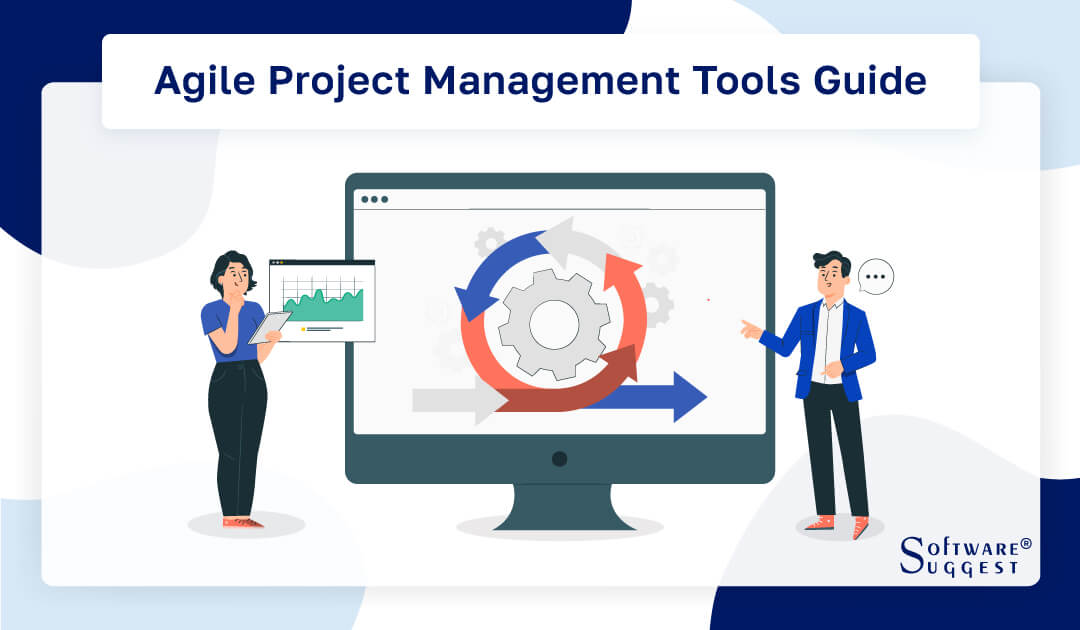
Agile management tools have become integral in modern project management, revolutionizing how teams collaborate, plan, and execute tasks within dynamic work environments. As businesses increasingly adopt Agile methodologies to enhance flexibility, responsiveness, and value delivery, these software solutions play a pivotal role in enabling teams to embrace iterative development, foster collaboration, and adapt swiftly to changing requirements.
With a diverse array of features catering to different Agile frameworks, these tools empower organizations to streamline workflows, improve communication, and achieve greater efficiency in delivering high-quality products or services.
What are Agile Project Management Tools?
Agile project management tools are software solutions designed to assist teams in planning, executing, and tracking tasks and projects using Agile methodologies. These tools cater to the unique requirements of Agile workflows, promoting iterative development, collaboration, and adaptability. They offer features such as user story mapping, sprint planning, task boards (like Kanban boards), burndown charts, and backlog management.
Some popular Agile project management tools include Jira, Trello, Asana, Monday.com, and Microsoft Azure DevOps. These platforms streamline communication among team members, enhance transparency, enable better prioritization of tasks, and facilitate quick adjustments to project requirements based on feedback, ensuring teams can effectively deliver high-quality results in a flexible and responsive manner.
What Are the Different Types of Agile Management?
Agile management refers to a set of methodologies and frameworks that prioritize iterative, collaborative, and adaptive approaches to project management. These methodologies aim to deliver value to customers efficiently while responding effectively to change.

-
Kanban
Kanban is a visual Agile management method that focuses on continuous delivery by visualizing work through a Kanban board. This board consists of columns representing stages of work and cards representing tasks. Teams move these cards through the workflow stages, facilitating transparency and flexibility in managing work in progress. Kanban tools emphasize workflow optimization, limiting work in progress (WIP), and promoting a pull-based system where work is pulled into the pipeline as capacity allows.
-
Scrum
Scrum is perhaps the most widely used Agile framework. It operates in short iterations called sprints, usually lasting 2-4 weeks. Scrum software includes predefined roles like Scrum Master, Product Owner, and Development Team, as well as specific ceremonies such as daily stand-ups, sprint planning, sprint review, and sprint retrospectives. The framework emphasizes self-organization, collaboration, and regular reflection to continuously improve the team's productivity and product quality.
-
Extreme Programming (XP)
Extreme Programming is an Agile methodology focused on engineering practices to enhance software quality and responsiveness to changing requirements. XP emphasizes principles like pair programming, test-driven development (TDD), continuous integration, simple design, and frequent releases. It aims to deliver high-quality software by emphasizing customer involvement, frequent communication, and a fast feedback loop.
-
Adaptive Software Development (ASD)
Adaptive Software Development emphasizes collaboration among stakeholders and adaptation to changing circumstances. It divides the project into speculation, collaboration, and learning phases. ASD is focused on constant adaptation based on the learning acquired throughout the project's lifecycle, aiming to produce a high-quality product that aligns with evolving customer needs.
-
Agile Unified Process (AUP)
Agile Unified Process is a simplified version of the Rational Unified Process (RUP), integrating Agile principles into the iterative development process. AUP provides guidelines and best practices for project management, including requirements, analysis, design, implementation, testing, and deployment. It aims to maintain flexibility while still providing enough structure to manage projects effectively.
Who Are the Users of Agile Project Management Tools?
Agile project management tools cater to a diverse set of users involved in various capacities throughout the software development lifecycle. These tools are designed to streamline collaboration, enhance transparency, and facilitate the Agile methodology's implementation. Among the key users of Agile project management tools are:

-
Scrum Masters
Scrum Masters are responsible for ensuring that the Scrum framework is understood and implemented effectively. They use Agile project management tools to facilitate Scrum ceremonies, manage the Scrum board, track sprint progress, and identify and address impediments that may hinder the team's progress. These tools assist Scrum Masters in visualizing work, conducting retrospectives, and fostering collaboration among team members.
-
Stakeholders
Stakeholders play a crucial role in Agile projects as they provide valuable insights, feedback, and requirements. Agile project management tools enable stakeholders to have visibility into project progress, participate in discussions, prioritize features or user stories, and provide real-time feedback. They can access information on project status, timelines, and potential bottlenecks, allowing them to make informed decisions and steer the project in the desired direction.
-
UX/UI Designers
UX/UI designers contribute to the user-centric aspect of software development. Agile project management tools assist them in visualizing design iterations, managing design assets, collaborating with cross-functional teams, and incorporating feedback from users or stakeholders. These tools provide a platform for designers to share prototypes, gather feedback, and ensure alignment between design and development teams, fostering a cohesive workflow.
-
Agile Coaches
Agile coaches support teams in adopting and refining Agile practices. They utilize Agile project management tools to educate teams on Agile principles, coach them on best practices, and monitor the team's adherence to Agile methodologies. Coaches leverage these tools to analyze metrics, identify areas for improvement, and guide teams toward continuous improvement, fostering an environment conducive to Agile values and principles.
What Are the Benefits of Using the Best Agile Project Management Software?
Agile project management software offers a myriad of benefits, enhancing productivity, decision-making, communication, issue detection, and risk management within project teams. These advantages significantly contribute to the success of Agile-driven projects.

-
Improved Productivity
Agile project management software streamlines workflows, allowing teams to organize tasks, prioritize work, and track progress efficiently. With features like task boards, backlog management, and sprint planning, teams can focus on delivering incremental value. It encourages a more iterative and focused approach, boosting productivity by breaking down complex projects into manageable, actionable tasks.
-
Faster Decision-Making
The real-time visibility provided by Agile tools facilitates quicker decision-making. Teams have access to up-to-date project data, allowing for informed decisions based on current progress, feedback, and changing priorities. Features like dashboards, reporting, and analytics enable stakeholders to grasp the project status, aiding in prompt decision-making to keep the project on track.
-
Enhanced Communication
Agile tools promote transparent and effective communication among team members and stakeholders. Collaboration features such as shared boards, discussions, and instant messaging facilitate seamless communication, reducing misunderstandings and ensuring alignment on project goals. Enhanced communication fosters a collaborative environment where ideas flow freely and issues are addressed promptly.
-
Detects Defects and Issues Faster
Agile project management software enables teams to detect defects and issues early in the development process. Continuous testing, frequent feedback, and iterative development cycles highlight problems sooner, allowing teams to address them promptly. This early detection helps prevent larger issues from arising later in the project, ultimately leading to higher-quality deliverables.
-
Risk Management
Agile methodologies emphasize adaptability and flexibility, enabling teams to manage risks effectively. Agile project management software assists in identifying and mitigating risks by allowing teams to prioritize tasks, adjust plans, and allocate resources dynamically. With iterative cycles and regular reviews, risks are continually assessed and managed throughout the project lifecycle using risk management software for businesses.
What Are the Features of Top Agile Project Management Software
Agile project management software is designed to facilitate and support the implementation of Agile methodologies in project workflows. It encompasses various features that cater to the iterative, collaborative, and adaptive nature of Agile practices. Some key features of top Agile project management tools include -
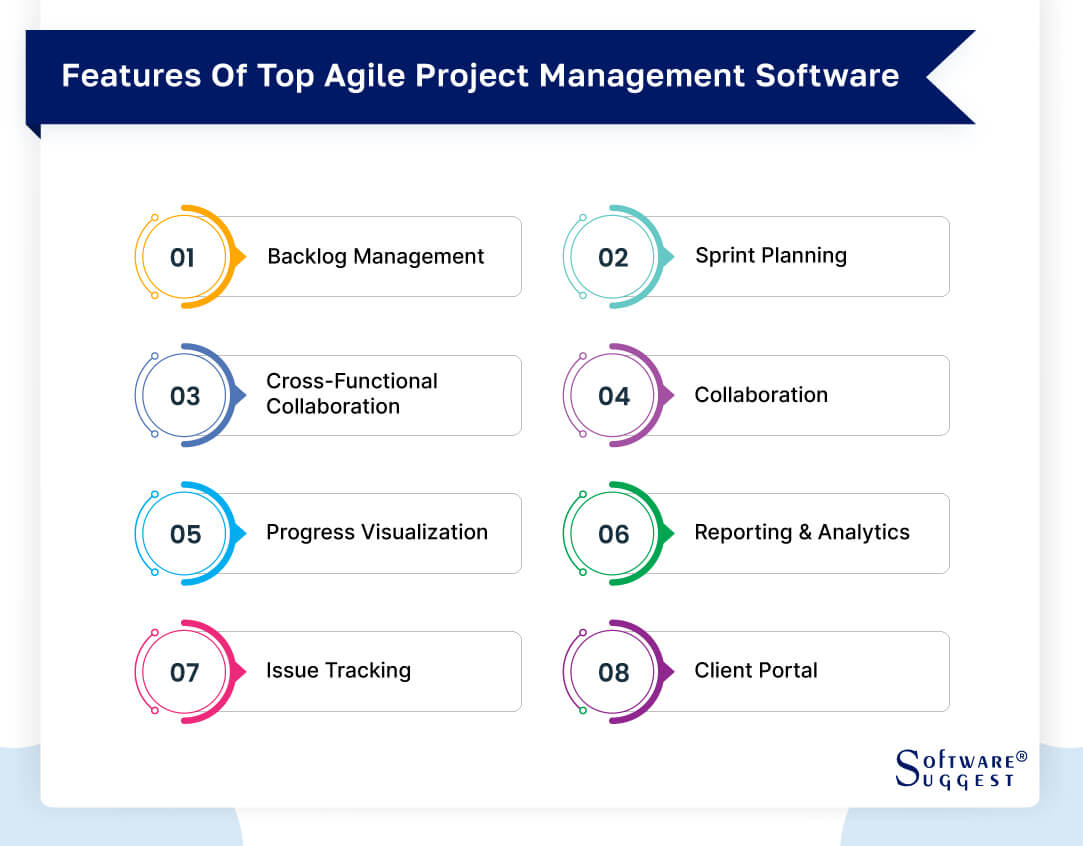
-
Backlog Management
Backlog management is a crucial feature in Agile project management software. It allows teams to create, prioritize, and manage a backlog of work items, such as user stories, tasks, bugs, or features. Teams can add, update, or re-prioritize backlog items based on evolving requirements; feedback, and changing priorities. This feature helps in maintaining a clear and organized list of work to be addressed in future sprints or iterations.
-
Sprint Planning
Sprint planning functionality assists teams in organizing and planning work for specific time-boxed iterations or sprints. Agile project management tools enable teams to select backlog items, define sprint goals, estimate effort, and allocate tasks among team members. This feature aids in breaking down work into manageable units, setting achievable goals for each sprint, and establishing a clear direction for the team's activities within the sprint timeframe.
-
Cross-Functional Collaboration
Agile emphasizes collaboration among cross-functional teams, and Agile project management software facilitates this collaboration. Tools offer features like shared boards, real-time updates, commenting, file sharing, and task assignments, fostering collaboration among team members regardless of their geographical locations. These collaboration features promote transparency, communication, and alignment among team members, enabling them to work together efficiently towards common project goals.
-
Collaboration
Managing long email chains is challenging. Similarly, so is working a different chat window to discuss a project with your team members or other stakeholders!
With a centralized collaboration tool that integrates with agile project management solutions, the management becomes smooth for project managers. In addition, sharing information gets more accessible and removes the redundancy of long email chains.
-
Progress Visualization
Progress visualization makes it easier for the team members to see their teams and progress and contribute to the project effectively. In addition, you can identify bottlenecks and take proper action.
-
Reporting and Analytics
In-depth reports and analytics are crucial for project managers to analyze their team's performance and review progress at each milestone. With insightful words, managers can efficiently divide resources and manage tasks for future projects.
-
Issue Tracking
Bugs and issues are part of any and every agile project. Identifying and resolving them is the most crucial part. With issue tracking, teams can work on pieces that require immediate attention. As a result, software developers use issue-tracking features the most.
-
Client Portal
With detailed client feedback, teams and managers can know why the project lags. Good feedback keeps the team motivated, ensuring better work in the future. An agile project management platform is the best option for last-minute changes, but it is always better to get things done faster.
What are the use cases of Agile Project Management Tools?
Implementing Agile tools and techniques can prove to be highly beneficial for startups and enterprise businesses. From standups to doing sprint meetings, you can utilize agile tools at every step. The essential agile tools and techniques are -
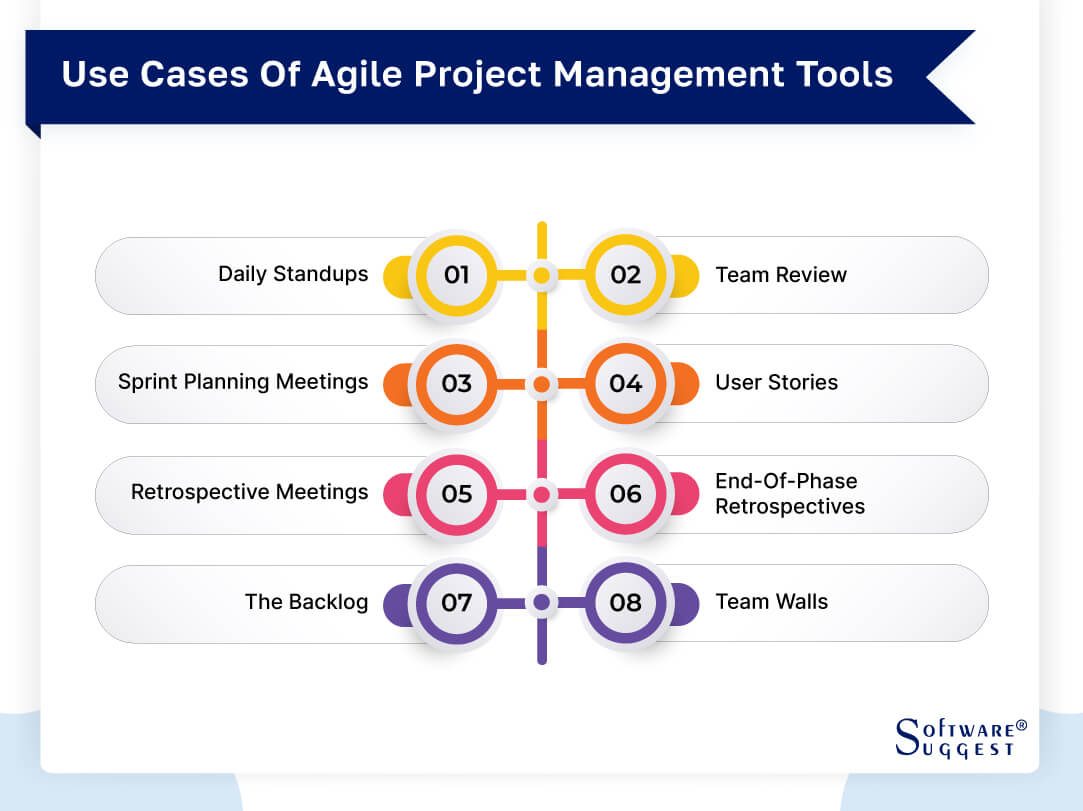
1. Daily Standups
It is a daily meeting where the team discusses their work and issues they need to resolve. Standups must be held simultaneously every day and not last more than fifteen minutes.
2. Team Review
It is a regular meeting that allows team members to demonstrate their work. It is also known as show and tell. You can invite stakeholders to the meeting and use it to say to them about your user stories' completion. It allows you to show the crucial work you've done and lets other teams see your work.
3. Sprint Planning Meetings
In sprint planning meetings, the teams decide what to work on next and how they'll do it. The length of the session depends on the size of the sprint.
4. User Stories
It is a way to record things you need to build the service briefly. You can also prompt discussions about the features when ready to work on them.
5. Retrospective meetings
It is a meeting where your team talks about what is going on well and what isn't! Most groups usually hold retrospective meetings at the end of an iteration. Retrospective meetings fix problems and ensure everything works fine in the team.
6. End-of-Phase Retrospectives
Numerous teams run a more extended retrospective meeting at the end of alpha, beta, and discovery. It includes people who have been included and involved in the work from outside the team, like policy or procurement colleagues.
End-of-phase retrospectives can:
-
Help people from policy, procurement, or other disciplines work effectively with service teams across the broader organization.
-
Identify areas to improve in the next phase of the project.
7. The Backlog
The backlog is where your team stores the user stories not yet started in order of priority.
8. Team Walls
Your team wall is where you keep a visual record of your work. The border shows your team's past, present, and future work. Team walls help your team collaborate and allow other organization members to see what you're doing.
How to Select the right Agile Management Tools?
The top factors to consider while selecting an agile project management software are:
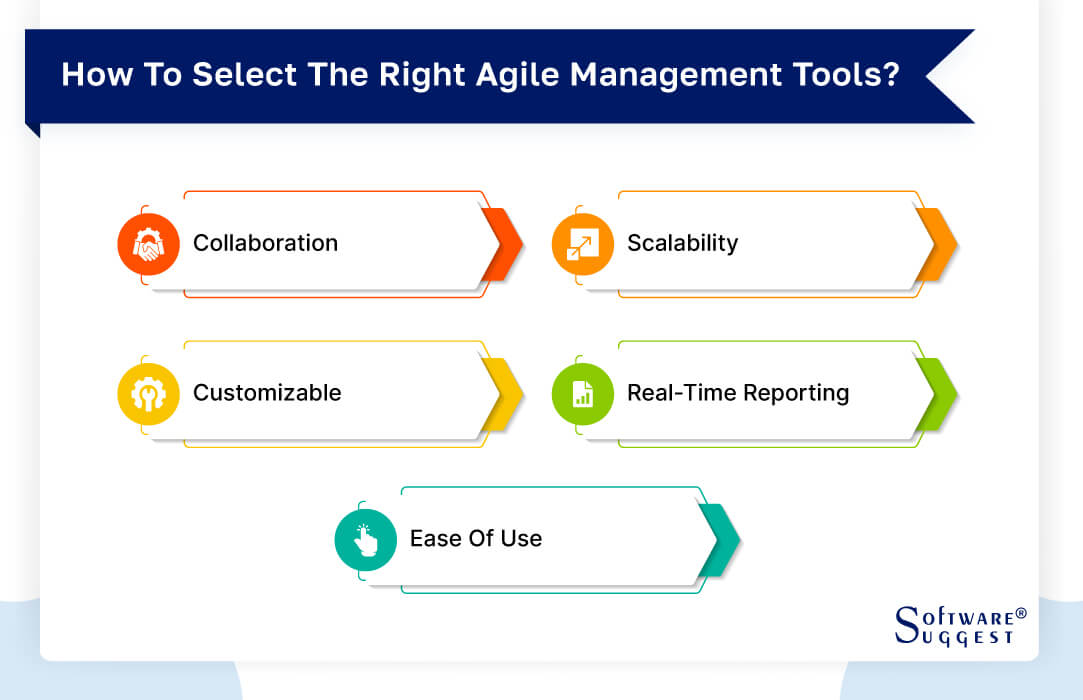
-
Collaboration
The agile project management solution must allow collaboration on projects to help teams work together, both remotely and on-site. Collaboration makes it easier for every team member to contribute input at every stage of the product.
-
Scalability
With the growth of your business, the demand for software grows exponentially. But, with limited features, your business will face setbacks. Don't let that happen. First, check whether the software you want to integrate has storage space or additional modules. Then, consider the one that helps your business grow.
-
Customizable
No need to change how an organization runs to accommodate a new system. With the best agile project management tools, you can easily configure it to fit your organization's needs. So, paying attention to the software's customization type is essential! In addition, your agile project management platform must be flexible enough to consider business working patterns.
-
Real-time Reporting
Real-time reporting is the real winner! With real-time reporting solutions, you can pull data from different areas of the project management software to instantly use it and yield reports about the current status of your project.
-
Ease of Use
Easy-to-use tools are always a positive sign for users. But often, many tools are critical and require multiple days of training. So, organizations must look for an agile project management tool that is straightforward and suits their business needs. User experience is of crucial importance. Easy-to-use software boosts productivity as well.
Latest Market Trends in Agile Project Management Software
As businesses continue to evolve and adapt to changing dynamics, the realm of Agile project management software has also witnessed ongoing advancements and trends. These latest market trends reflect the need for enhanced flexibility, scalability, security, and accessibility in managing Agile projects effectively.
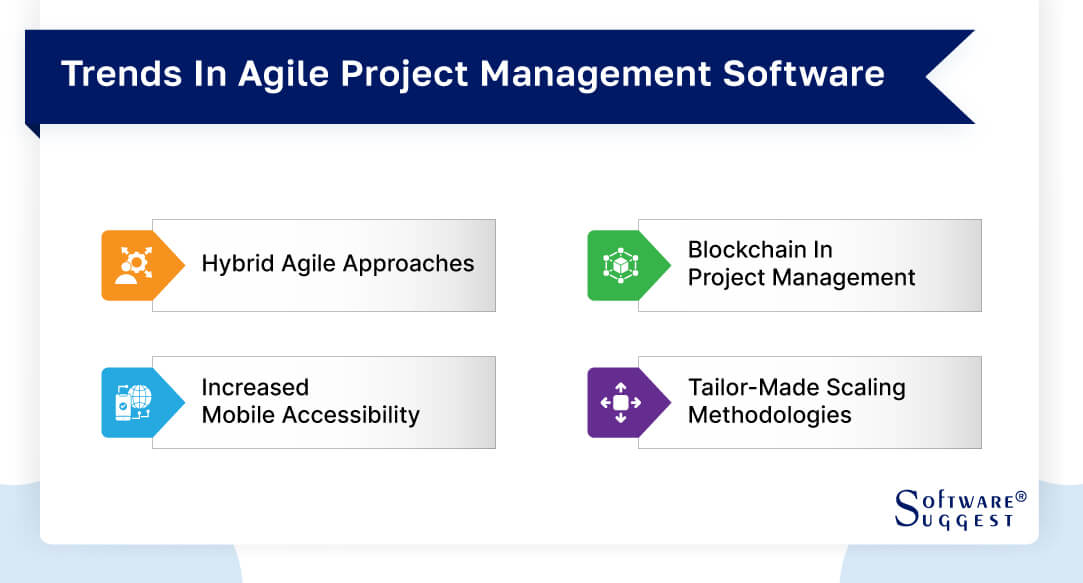
-
Hybrid Agile Approaches
One of the notable trends in Agile management software is the emergence and adoption of hybrid Agile approaches. Organizations are increasingly combining elements from different Agile methodologies, such as Scrum, Kanban, Lean, or XP, to create hybrid frameworks that suit their specific project requirements. Software tools are evolving to accommodate these hybrid approaches, offering customizable features that allow teams to integrate various Agile practices seamlessly.
-
Blockchain in Project Management
Blockchain technology is gaining attention in the project management domain, offering increased transparency, security, and traceability. Some Agile project management software solutions are exploring the integration of blockchain to enhance data security, establish immutable records, and enable secure sharing of project-related information among distributed teams. Blockchain-based functionalities aim to improve trust, reduce fraud, and enhance accountability within Agile project management ecosystems.
-
Increased Mobile Accessibility
Another prominent trend is the growing emphasis on mobile accessibility in Agile project management tools. As remote work and distributed teams become more prevalent, there is a heightened demand for mobile-friendly software that enables users to manage projects, collaborate, and access crucial project data on-the-go. Software providers are focusing on developing responsive mobile applications or optimizing web interfaces for seamless use across various devices, empowering teams to stay connected and productive from anywhere.
-
Tailor-Made Scaling Methodologies
Enterprises undertaking larger and more complex projects require Agile methodologies that can scale effectively across multiple teams and diverse projects. To address this need, Agile project management software is increasingly offering tailor-made scaling methodologies. These methodologies aim to facilitate coordination and synchronization among multiple Agile teams working on interconnected projects. These tools provide features for managing dependencies, aligning goals, and ensuring consistency across different teams and projects within an organization.
What Is the Cost of the Agile Management Tool?
The cost of Agile management tools can vary significantly based on various factors such as the software provider, the specific features offered, the number of users, deployment options, and additional services or support provided. Generally, Agile tracking tools offer a range of pricing models including free versions with limited features, subscription-based models with tiered pricing plans based on functionalities or the number of users, and enterprise-level solutions tailored to specific organizational needs.
Entry-level Agile management tools or basic versions of popular platforms might have free plans available, often with limited capabilities or for a restricted number of users. As the feature set expands, prices typically increase. Subscription-based pricing for Agile tools often ranges from a few dollars per user per month for small teams to higher prices for larger enterprises or organizations requiring more advanced functionalities, customization options, or dedicated support.
Additionally, some Agile management tools may offer flexible pricing structures based on the level of customization, integrations with other software, scalability options, or the need for on-premises installations versus cloud-based solutions. Custom enterprise solutions may involve negotiating pricing based on specific requirements, additional features, or dedicated support services.
Conclusion
In conclusion, Agile management tools stand as indispensable assets for organizations navigating the complexities of modern project management. Their ability to facilitate transparency, encourage collaboration, and provide adaptability within teams fosters an environment conducive to innovation and continuous improvement. As the landscape of work evolves, these tools will continue to evolve, offering enhanced functionalities and capabilities to meet the ever-changing demands of Agile-driven projects.
The enduring impact of Agile management tools lies in their capacity to empower teams, optimize processes, and ultimately drive success in delivering value to customers in an ever-evolving business landscape.
FAQs
List of is the best agile project management software.
- Wrike
- Monday.com
- Zoho Sprints
- Asana
- Jira Agile
Some agile project management examples are:
- XP
- SCRUM
- Lean software development
- Adaptive software development
- Feature-driven development
An agile project management tool helps in managing and executing an agile project.
Agile methodology is an iterative approach to project management and software development that emphasizes flexibility, collaboration, customer feedback, and continuous improvement. It focuses on breaking down projects into smaller, manageable tasks and delivering value in short iterations called sprints. Agile methodologies, such as Scrum, Kanban, and Extreme Programming (XP), prioritize adaptability to change, customer satisfaction, and early and frequent delivery of working software.
Agile project management tools typically don't have distinct phases like traditional project management methodologies. However, they facilitate various key stages throughout the project lifecycle:
Backlog Management: Creating and prioritizing a backlog of work items.
Sprint Planning: Planning and organizing work for specific time-bound iterations or sprints.
Execution & Tracking: Implementing tasks, tracking progress, and managing team activities during the sprint.
Review & Adaptation: Reviewing the completed work, gathering feedback, and adapting plans for continuous improvement.
Retrospective: Reflecting on the sprint, discussing what worked well and what needs improvement, and making adjustments for future sprints.















.png)





